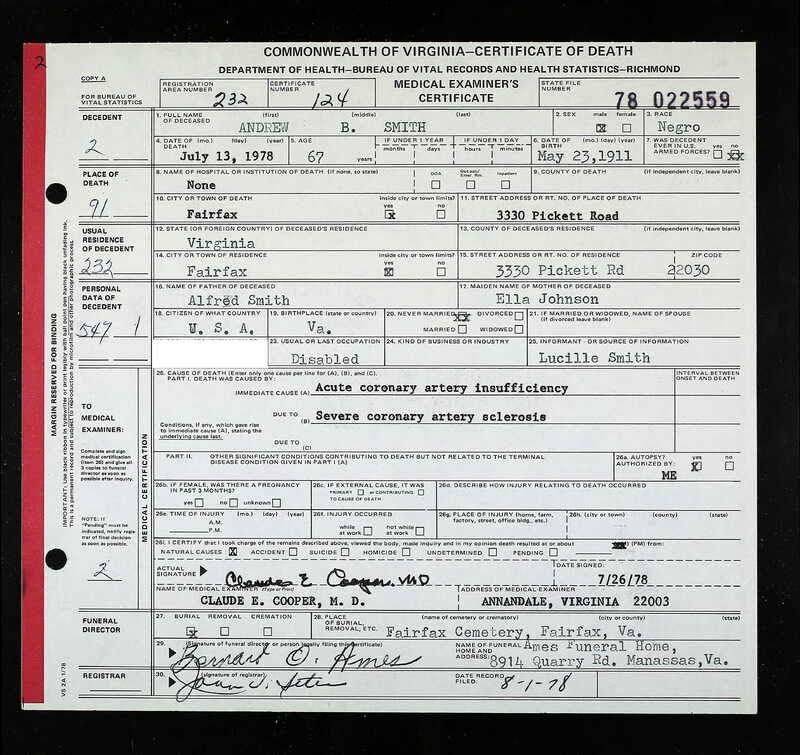"I Ain't Moving": Andy Smith and Memory
The town of Fairfax knew Andy Smith by name because he was renowned for waving to cars as he stood at the front of his trailer on busy Route 123. His home was situated on what is today George Mason University land. The Fairfax Public Works Director recalled that “everybody would talk to him” even “people all dressed up in suits.” It was said with irony and humor that “ol’ Andy…was a real contrast for Fairfax,” the upper-middle-class white suburb with neat yards and ten-room homes. In 1978 Andy Smith passed away. His death certificate stated that he was a “Negro.” The deceased Andy Smith went to Bernard Ames from Ames Funeral home in Manassas, which served Black communities in Fairfax since 1959. A subsequent homegoing ceremony was performed in Andy Smith's honor at Mount Cavalry Baptist, a church founded in 1870 by formerly enslaved people. Hundreds attended. A young girl sang at the service; she was followed by a Sunday school teacher who read a eulogy that was “10 typed pages.” The Washington Post journalist sent to cover the event wrote an article that quoted Fairfax City Street Superintendent C. Wayne Marteny: "Here you had all these people praying for an old colored man who done nothing in his life but be a good human being…It was kind of inspiring.”[1] Andy Smith was laid to rest in the Fairfax County Cemetery.
Five years later Andy Smith was again remembered, this time as “The Lover." The Fairfax Mayor, Nathaniel Young, used those two words to describe the man who "love[d] everybody" in a "world" that "need[ed] a lover." This catchy line referred to the same Andy Smith that the municipality sought to evict at least once--after George Mason College dislodged him from a trailer on the Farr family's former property.[2] This romantic depiction is one of the few accounts of Andy Smith's legacy. It belies the fact that his existence in Northern Virginia was hard and precarious. Smith found residences where he could. They barely provided him with security. Andy Smith also experienced homelessness.
More work is needed to understand who Andy Smith was and what kindred communities he belonged to. One of the only recorded statements he purportedly made--now available in the public record--was in reponse to a landlord's attempt to remove him from a modest small home. His quoted phrase carries greater meaning when it is considered that during his lifetime he personally witnessed the Black population in Fairfax County dwindle to almost nothing. Smith responded to the threat of eviction this way: “I ain’t moving.”[4]
By George Oberle
[1] “The ‘Lover,’” The Washington Post, March 25, 1983.
[2] “The ‘Lover,’” The Washington Post, March 25, 1983.
[3] Mike Sager, “Fairfax County’s Dreary Graveyard For the Destitute, Adrift or Anonymous: Potter’s Field,” The Washington Post, March 25, 1983.
[4] Douglas C. Lyons, “What to Do With Andy Smith? He Doesn’t Want to Move,” The Washington Post, April 14, 1975.

